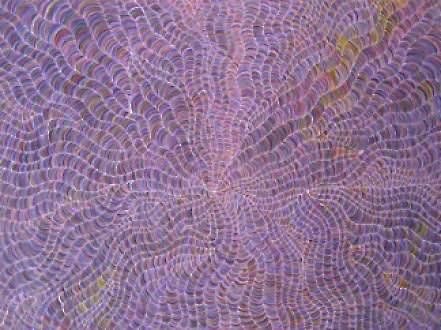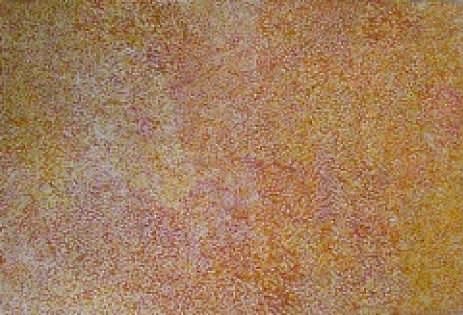Songlines XXI: Paintings from Utopia : Group Show
Utopia is a region in central Australia, around 300 km north east of Alice Springs, named after the cattle station established in the area in the 1920s. After a successful land claim, the region was handed back to the Anmatyerr and Alywarr people as Aboriginal freehold land in 1979 and small family groups live at several outstations close to their ancestral land in an area roughly 3,500 square kilometres.
The desert landscape of Utopia changes with the seasons and features grassy plains and rocky outcrops along the main waterway, the Sandover River, which is often simply a dried sandy expanse dotted with trees. The summer is hot and dry yet in winter time the temperature can drop below zero degrees at night. The features and colours of the region are reflected in the art: the fine dots of grass seeds and bush fruit, the azure expanse of sky, the bright orange-red sand, the soft yellow-green grass, the white ghost gums, the white dotted flowers of the bush plum, the tracks in the sand of the bush turkeys, the rainbow colours of spring flowers.
The art of Utopia is characterised by an elegant painterliness, a sense of movement created by thousands of dots of pure colour rained across the canvas or through a bold linear style, and a subtle use of colour. The mostly women artists paint their country with intimate knowledge: a memory of tracking to ceremonial sites, waterholes, places for hunting and gathering of food, places of shelter, neighbouring countries; places of personal histories and of ancestral and spiritual significance. The paintings are “about memory, a landscape of observations and sensory perceptions, recalled from a lifetime relationship with their country.” They are like “a contour map of defining one’s sense of self and of place and of understanding their world.” [Two Sisters, Simon Turner, 2002]
Art has always been important in Utopia with body painting and sand paintings for ceremonial purposes. The contemporary art movement of Utopia has its roots in the introduction of batik in the late 1970s through Jenny Green and Julia Murray. The women successfully translated depictions of plants and animals mixed with lines and dots to the lengths of silk. This led to an exhibition of 88 batiks, A Picture Story, which were acquired by the Holmes à Court collection and shown around the world.
Rodney Gooch instigated the next project in the late 1980s, introducing the artists to painting with acrylic on canvas. Many designs were derived from body paint which is in direct association with the act of painting.
The paintings of Alyawarr and Anmatyerr speaking Aboriginal artists are contemporary dialogues or translations of the oldest laws and culture. Their paintings have arisen through the stories of their cultural heritage and depictions of the food and plants of their landscape. Although the paintings are individual in creation, the stories and countries depicted are shared by many. For these artists, painting is a modern language that crosses all boundaries — cultural, geographical, social and religious.
One of the most celebrated artists to emerge from Utopia is Emily Kngwarray — whose work continues to be exhibited on an international level as a leading example of Australian contemporary art, particularly with her representation at the Venice Biennale in 1997. Emily proved an important model and teacher for many artists still working at Utopia today.
Her painting reflects the fluidity and confident marks that continue to characterise the work of artists from Utopia. One of the most enduring symbols used by these painters is the dot - from the finesse of Kathleen Petyarr, Cowboy Loy and Elizabeth Kunoth, to the mosaic coloured dotting of Angelina Ngal and the subtle shifts of colour under a layer of white dots as seen in Kathleen Ngal’s work, to the swirl of little leaves painted by Gloria Petyarr, to the vivid vision of the Artists of Ampilawatja.
Leading artists of Utopia today include the Petyarr sisters and Ngal sisters. Kathleen Petyarr was awarded the 13th Telstra National Aboriginal & Torres Strait Islander Art Award in 1996 and was the subject of a solo exhibition at the Museum of Contemporary Art in Sydney in 2001. She paints the travels of Arngertea, the Mountain Devil, as does her sister Nancy Petyarr. Both artists draw on diagonal tensions in their compositions; illustrating travels, lakes, rocks and sacred sites. Gloria Petyarr has exhibited widely both in Australia and internationally, and her paintings revolve around two main motifs: the linear body paint associated with women’s ceremony, Awelye and Bush Medicine Leaves. Gloria’s work is derived from her cultural heritage and stories of Anungra, her country. Her work successfully embraces indigenous traditions and themes current in international contemporary art such as her use of abstraction, colour and form. Gloria is receptive to her land and culture and is able to articulate their nuances in ever-evolving abstract visions. Her Leaf paintings depict the feathery brushstrokes and a vibrant use of colour. The abstractedness of her Awelye paintings, often emphasised by the simple use of black and white, belies the narrative content and ceremonial importance.
Kathleen and Poly Ngal are senior custodians and keepers of cultural knowledge for their country, Arlparra. Poly’s paintings often depict bright yellow seeds, feast for the emus, amongst Bush Plums that grow in her country. Her paintings are borne from traditional knowledge and the confident approach to her work can be seen in the way she assembles streams of seeds, piling dots upon each other to create rich fields of glowing colour. Kathleen’s work is a sophisticated representation of the flora and geographical and sacred sites related to the Bush Plum.
Like her sister, Angelina Ngal paints her country, Arlparra, gaining international recognition for the way she captures the significance of her country through layers of colourful dotting. Her paintings can be appreciated at a superficial level for their abstractionism and painterliness. The deeper layer which depicts the cultural and social mores of her society requires further probing to be read. Like the famed Emily Kngwarray, Angelina exhibits a progressive quality in her painting.
-
 Gloria Tamerr Petyarr, Leafs, 2008
Gloria Tamerr Petyarr, Leafs, 2008 -
 Elizabeth Kunoth Kngwarray, Yam seeds and flowers, 2008
Elizabeth Kunoth Kngwarray, Yam seeds and flowers, 2008 -
 Elizabeth Kunoth Kngwarray, Yam Seeds and Flowers (detail), 2008
Elizabeth Kunoth Kngwarray, Yam Seeds and Flowers (detail), 2008 -
 Kathleen Ngal, Flowers of the bush plum, 2008
Kathleen Ngal, Flowers of the bush plum, 2008 -
 Sarah Morton Kngwarray, Sweet Fruits from lunita tree, 2008
Sarah Morton Kngwarray, Sweet Fruits from lunita tree, 2008 -
 Gloria Tamerr Petyarr, Awelye , 2001
Gloria Tamerr Petyarr, Awelye , 2001 -
 Genevieve Kemarr Loy, Bush turkey story, 2007
Genevieve Kemarr Loy, Bush turkey story, 2007 -
 Elizabeth Kunoth Kngwarray, Yam Seeds and Flowers, 2008
Elizabeth Kunoth Kngwarray, Yam Seeds and Flowers, 2008 -
 Lucky Morton Kngwarrey, Rainbow country, 2008
Lucky Morton Kngwarrey, Rainbow country, 2008 -
 Angelina Ngal ('Pwerl'), Bush plum at aharlper, 2008
Angelina Ngal ('Pwerl'), Bush plum at aharlper, 2008 -
 Gloria Tamerr Petyarr, Awelye, 2008
Gloria Tamerr Petyarr, Awelye, 2008 -
 Kathleen Petyarre, Mountain devil dreaming, 2007
Kathleen Petyarre, Mountain devil dreaming, 2007 -
 Lucky Morton Kngwarrey, Rainbow country, 2007
Lucky Morton Kngwarrey, Rainbow country, 2007 -
 Poly Ngal, Emu seed country, 2007
Poly Ngal, Emu seed country, 2007 -
 Elizabeth Kunoth Kngwarray, Bush seeds, 2007
Elizabeth Kunoth Kngwarray, Bush seeds, 2007 -
 Cowboy Loy Pwerl, Bush Turkey Dreaming, 2008
Cowboy Loy Pwerl, Bush Turkey Dreaming, 2008 -
 Kathleen Petyarre, My country, shandhills after sandstorms, 2003
Kathleen Petyarre, My country, shandhills after sandstorms, 2003 -
 Sarah Morton Kngwarray, The fruits from the lunita tree, 2007
Sarah Morton Kngwarray, The fruits from the lunita tree, 2007 -
 Genevieve Kemarr Loy, Bush turkey dreaming, 2007
Genevieve Kemarr Loy, Bush turkey dreaming, 2007 -
 Angelina Ngal ('Pwerl'), Aharlper country, 2007
Angelina Ngal ('Pwerl'), Aharlper country, 2007 -
 Kathleen Petyarre, Thorny devil lizard dreaming hailstorm, 2003
Kathleen Petyarre, Thorny devil lizard dreaming hailstorm, 2003 -
 Poly Ngal, Emu seed country, 2006
Poly Ngal, Emu seed country, 2006 -
 Nancy Kunoth Petyarr, Awelye, 2007
Nancy Kunoth Petyarr, Awelye, 2007 -
 Nancy Kunoth Petyarr, Mountain devil dreaming, 2009
Nancy Kunoth Petyarr, Mountain devil dreaming, 2009 -
 Genevieve Kemarr Loy, Bush turkey story, 2007
Genevieve Kemarr Loy, Bush turkey story, 2007 -
 Lucky Morton Kngwarrey, Rainbow country, 2009
Lucky Morton Kngwarrey, Rainbow country, 2009 -
 Angelina Ngal ('Pwerl'), Aharlper country, 2008
Angelina Ngal ('Pwerl'), Aharlper country, 2008 -
 Louie 'Cowboy' Pwerle, Bush Turkey Dreaming, 2007
Louie 'Cowboy' Pwerle, Bush Turkey Dreaming, 2007 -
 Gloria Tamerr Petyarr, Awelye, 2006
Gloria Tamerr Petyarr, Awelye, 2006 -
 Kathleen Ngal, Bush plum country, 2007
Kathleen Ngal, Bush plum country, 2007 -
 Angelina Ngal ('Pwerl'), Grandfather's country, 2007
Angelina Ngal ('Pwerl'), Grandfather's country, 2007 -
 Gloria Tamerr Petyarr, Leafs, 2005
Gloria Tamerr Petyarr, Leafs, 2005 -
 Cowboy Loy Pwerl, Bush Turkey Dreaming , 2007
Cowboy Loy Pwerl, Bush Turkey Dreaming , 2007


































